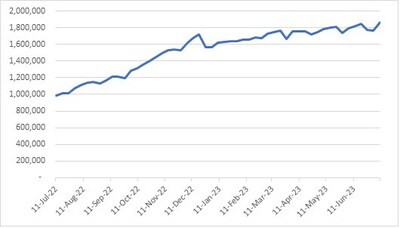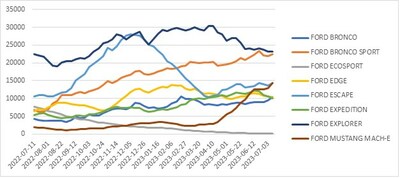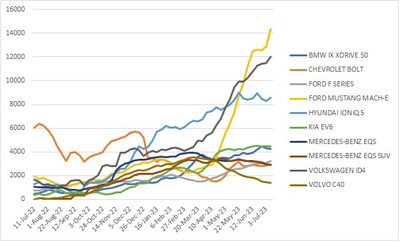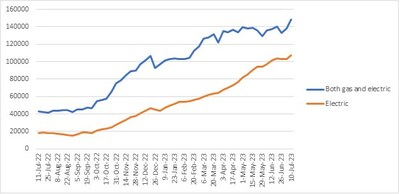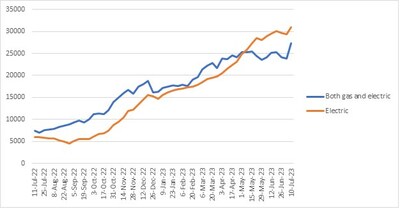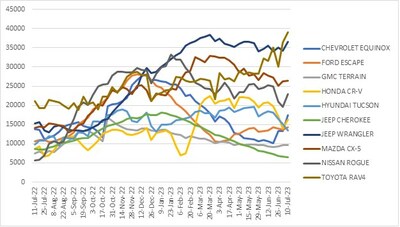S&P Global Mobility Shares July US Auto Inventory Trends
The impact of the July 4 weekend sales events, Ford Mach-E inventory numbers climbing past ICE SUVs, and the looming Compact SUV dogfight in the US market.
And while July 4 sales events received their typical promotions, the pattern for the long weekend was consistent to recent months-end in terms of sold inventory. The July 4 weekend also represented a trifecta of the end of the month, end of the quarter, and a holiday.
But while the long weekend took a chunk out of available advertised inventories – from 1.843 million in mid-June to 1.761 million on July 3, perhaps more notable is that available inventories almost immediately leaped ahead to 1.867 million by mid-July, surpassing the year-to-date highs seen in mid-June.
Ford Mach-E inventories climbing past ICE SUVs
You can tell an automaker is serious about electric vehicles when advertised inventories climb to the equivalent level of its better-selling internal-combustion vehicles.
That is now happening with Ford SUVs, as inventories grow for the Ford Mustang Mach-E. In December, the Mach-E had the lowest advertised inventory count of any Ford SUV. As of early July, however, Ford dealers are now advertising more available Mach-E volume (14,363 units) than those of EcoSport, Bronco, Edge, and now, even Escape. Only the Explorer and Bronco Sport have more advertised units available.
Whether production is ramping up to meet anticipated demand, or whether there is sufficient demand to reduce inventories, remains to be seen. Year-to-date through June, Ford sold 14,040 units of the Mach-E, according to company reports, although inventories were constrained through the first quarter, and the sales pace has recently accelerated. By contrast, Ford has sold 64,839 Escapes over that period.
Non-Tesla EV inventories plateauing?
While Mach-E inventories are surging, most other EVs appear to be growing as well, but not at the same rate. Total advertised EV inventories reached 108,000 units in early July, up about 10,000 units from early June.
The other mainstream EV chasing volume is the Volkswagen ID.4; with about 12,000 units of advertised inventory (VW sold 6,690 units in 2Q 2023, but, again, with constrained inventories). The third-most advertised inventory is from the Hyundai Ioniq 5, although after an early-year surge of inventory through April, advertised stock appears to have flattened into a predictable wavelet pattern. The Kia EV6 shows a similar trend to the Hyundai – albeit at much lower volumes. The only EV showing a significant tapering of inventories is the Volvo C40.
Geographically, most of the industry EV inventory resides in the following DMAs:
EV inventories passing Hybrids?
A true measure of EV penetration is comparing advertised inventory volumes against Hybrid Gas-Electric vehicles.
Nationally, even as inventories of all vehicles have grown, there has been a consistent gap of about 35,000 to 40,000 units of Hybrids compared to EVs – as of inventory levels on July 10 there were 148,761 Hybrids to 107,514 EVs. However,
Early-July numbers show a sharp spike in growth of Hybrid inventories both nationally and in
Toyota rejoins the Compact SUV fight
The most competitive segment in the industry involves mainstream Compact SUVs, and a dogfight looks to be emerging through the summer months as the traditional sales leader appears to have regained its inventory footing.
The Toyota RAV4 has been the best-selling passenger vehicle in the US since 2017. But pandemic-related supplier shortages crunched Toyota inventories, resulting in a
As recently as April, Toyota had fewer RAV4s on the ground compared to Jeep Wrangler, Nissan Rogue, and Mazda CX-5. That tide is now turning, as RAV4 inventories have soared in late June and early July – just in time for the summer selling season – now reaching nearly 40,000 advertised units. Meanwhile, the RAV4's closest rival, the Honda CR-V, saw inventories dip sharply below 15,000 units in late June before seeing a slight jump in early July.
About S&P Global Mobility
At S&P Global Mobility, we provide invaluable insights derived from unmatched automotive data, enabling our customers to anticipate change and make decisions with conviction. Our expertise helps them to optimize their businesses, reach the right consumers, and shape the future of mobility. We open the door to automotive innovation, revealing the buying patterns of today and helping customers plan for the emerging technologies of tomorrow.
S&P Global Mobility is a division of S&P Global (NYSE: SPGI). S&P Global is the world's foremost provider of credit ratings, benchmarks, analytics and workflow solutions in the global capital, commodity, and automotive markets. With every one of our offerings, we help many of the world's leading organizations navigate the economic landscape so they can plan for tomorrow, today. For more information, visit www.spglobal.com/mobility.
Editor's Notes: S&P Global Mobility calculates advertised inventories both by total inventories – which includes some vehicles that have already been sold but are still advertised by dealers – as well as by available inventories that have not had their registrations punched, which is a slightly lower number.
Additionally, our July US Sales preview can be found here for reference.
Media Contact:
Michelle Culver
S&P Global Mobility
248.728.7496 or 248.342.6211
Michelle.culver@spglobal.com
![]() View original content to download multimedia:https://www.prnewswire.com/news-releases/sp-global-mobility-shares-july-us-auto-inventory-trends-301885535.html
View original content to download multimedia:https://www.prnewswire.com/news-releases/sp-global-mobility-shares-july-us-auto-inventory-trends-301885535.html
SOURCE S&P Global Mobility







